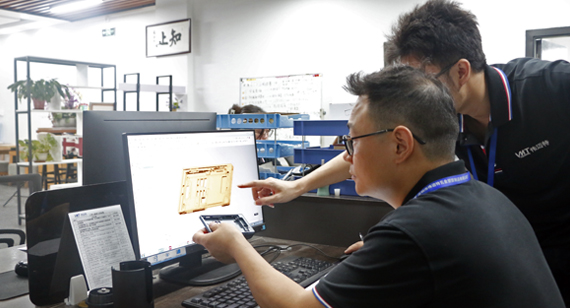15 years one-stop China custom CNC machining parts factory

Hey there I’m VMT Sam!
With 25 years of CNC machining experience we are committed to helping clients overcome 10000 complex part-processing challenges all to contribute to a better life through intelligent manufacturing. Contact us now
 55 |
Published by VMT at Jun 26 2025 | Reading Time:About 2 minutes
55 |
Published by VMT at Jun 26 2025 | Reading Time:About 2 minutes
Problem: You’ve poured heart and soul into designing a cutting-edge product. Your CAD files are pixel-perfect, the structure is sleek, and the function is revolutionary. But when you send those blueprints off for CNC precision machining, reality hits: lead times stretch, costs balloon, and prototypes don’t match the design intent.
Agitation: Missed deadlines, repeated design revisions, and hidden manufacturing pitfalls can derail your entire project. Poor surface finishes, dimensional inaccuracies, and costly material waste leave you frustrated—and your stakeholders even more so.
Solution: Enter DFM planning. Design for Manufacturability (DFM) bridges the gap between visionary design and efficient CNC machining. By integrating manufacturing expertise early—optimizing part geometry, tool access, material flow, and process sequence—you mitigate risk, slash time to sample, and deliver high-quality precision parts on budget.
DFM planning ensures design-to-manufacture alignment by identifying and resolving manufacturing challenges early. It optimizes part geometry for CNC machining, recommends tooling strategies and surface-treatment processes, prevents costly redesigns, and accelerates prototype sampling. The result: faster lead times, controlled costs, improved quality, and a smoother transition to production.
Now that you understand how DFM planning can transform your CNC machining journey, let’s explore seven key areas where early manufacturability analysis delivers tangible benefits—and how you can implement these strategies in your next R&D cycle.

1. Design Optimization for CNC Precision Machining
Challenge: Complex geometries increase cycle times, require specialized tooling, and raise scrap rates.
Solution: Conduct a geometry-driven DFM review to simplify features, consolidate operations, and ensure tool access.
Table 1: Impact of Feature Complexity on Machining Cost and Time
| Feature Type |
Cycle Time Impact |
Cost Delta |
DFM Recommendation |
| Deep pockets |
+30% | +25% | Add access slots or redesign depth |
| Sharp internal corner |
+20% | +15% | Specify radius ≥0.5 mm |
| Thin walls (<1 mm) |
+25% | +20% | Increase thickness or add supports |
| Multiple setups |
+40% | +35% | Combine features into single setup |
2. Material Selection and Surface Treatment Alignment
Challenge: Design-specified alloys and finishes may be difficult to machine or require post-processes, increasing lead times.
Solution: Evaluate material alternatives and surface-treatment methods within DFM to balance performance and manufacturability.
3. Tooling Strategy and Process Planning
Challenge: Inadequate planning on tooling selection can lead to frequent tool changes, machine downtime, and inconsistent finishes.
Solution: Integrate tooling analysis into the DFM stage:
4. Tolerance and GD&T Rationalization
Challenge: Overly tight tolerances drive up scrap rates and inspection costs; too-loose tolerances compromise functionality.
Solution: Balance design intent with achievable tolerances in DFM:
5. Assembly and Downstream Process Integration
Challenge: Ignoring how parts will assemble or undergo finish processes can trigger rework post-sampling.
Solution: Map the entire value stream in DFM:
6. Prototype Ramp-Up and Sampling Efficiency
Challenge: Without a DFM “dress rehearsal,” first-off parts often require design tweaks, causing repeated sample cycles.
Solution: Treat DFM as a prototype rehearsal:
7. Cost Reduction and Lead-Time Compression
Challenge: Late-stage changes inflate project budgets and extend time-to-market.
Solution: Quantify cost impacts of design features during DFM:
Table 2: DFM Cost Impact Analysis for Common Features
| Feature |
Added Cost (%) |
Lead-Time Impact |
DFM Mitigation |
| Deep pocket | 25% | +3 days | Redesign for shallower depth |
| Tight tolerance |
30% | +2 days | Relax to standard tolerance class |
| Exotic coating |
20% | +5 days | Select faster-curing alternative |
| Complex fixturing |
15% | +1 day | Add reference surfaces pre-machining |
Implementing comprehensive DFM planning before sampling transforms the CNC precision machining process. You’ll save time, cut costs, improve quality, and transition smoothly from R&D to production. Partner with a CNC machining expert early—harness the power of design-for-manufacturability to unlock your product’s full potential.
Ready to revolutionize your next project with DFM-driven CNC precision machining? Contact us today for a free consultation!
Q1: What is DFM planning in the context of CNC precision machining?
A1: DFM (Design for Manufacturability) planning is the early-stage analysis where manufacturing engineers collaborate with designers to optimize part geometry, material selection, tooling strategies, and process sequences specifically for CNC machining. It identifies potential bottlenecks—such as difficult tool access, tight tolerances, and unfavorable surface-treatment requirements—and proposes design modifications to reduce cost, improve quality, and accelerate prototype sampling.
Q2: How does DFM planning reduce sampling iterations and accelerate time to market?
A2: By simulating the entire machining process during the DFM phase—using CAM toolpaths, virtual inspections, and pilot runs—you uncover issues before physical prototypes are produced. Early alignment on part features, tolerances, and process steps means fewer design revisions during sampling. This streamlined approach typically cuts sampling cycles by 30–50%, shaving weeks off lead times.
Q3: Can DFM planning improve the final quality of CNC precision machined parts?
A3: Absolutely. DFM planning ensures that part features are compatible with best-practice machining parameters—proper radii, standardized tolerances, optimized surface finishes, and efficient tooling sequences. By eliminating problematic geometries and adapting designs to real-world manufacturing constraints, you achieve higher dimensional accuracy, better surface quality, and more consistent batch-to-batch repeatability.
Ready To Start Your Next Project?
Get Instant Quote

Request a Free Quote
Send us a message if you have any questions or request a quote. We will get back to you ASAP!
